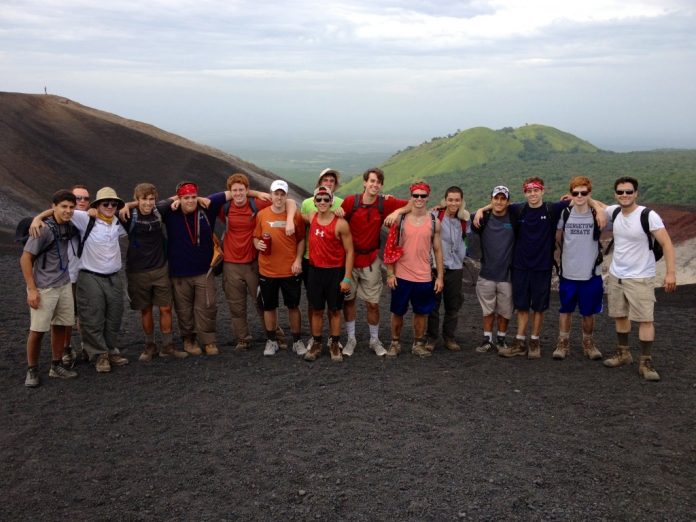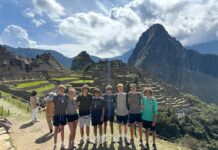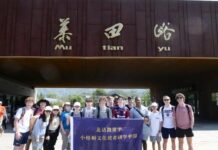With the exception of Mexico and the Bahamas, I have never genuinely been outside the privileged first world, and even then I was ensconced within the pampered and tourist-friendly resorts and restaurants that are so radically different from the true landscape just miles away. In other words, I haven’t seen how the other half lives- or more accurately, the other 80%.
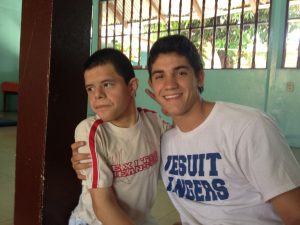 The developing world, I believe, will be an eye-opening experience that will give me a new paradigm of the foreign world. That said, as Robert Louis Stevenson notes, “There are no foreign lands. It is the traveler only who is foreign.”
The developing world, I believe, will be an eye-opening experience that will give me a new paradigm of the foreign world. That said, as Robert Louis Stevenson notes, “There are no foreign lands. It is the traveler only who is foreign.”
On this school mission trip to Nicaragua, I will be accompanied by approximately 75 students from three other Jesuit schools: Houston Strake, New Orleans and Tampa Bay. From my school, Jesuit Dallas, 13 of my brothers will join me on this journey: Jacob Keeley ’13, Robert Giltner ’13, Connor O’Hanlon ’13, Miguel Sotelo ’14, Collin Buechel ’15, Jack Kelley ’15, Michael White ’15, Bennett Harrison ’15, Patrick McNearney ’13, Austin Barker ’13, Nathan Krog ’13, Connor Fox ’13 and Alex Mersch ’13. Mr. Rich Perry, director of Community Service at Jesuit, and Mr. Keith Reese, a theology teacher, will lead our expedition.
Day 1: Travel, Travel and More Travel
It’s 4:00 AM; I slept for no more than 3½ hours. I gradually and painfully pull myself out of the cool cocoon of bed sheets. They will be dearly missed. I subsequently gather all of my belongings and head to DFW Airport for the 7:30 AM flight. Upon arrival, I meet my Jesuit brothers who will be making the journey, many of whom are making the trip for the second time.
As usual, security is moving at a snail’s pace. We eventually progress through, and parents say their last good byes, as we embark on our week-long trip.
After a classic McDonald’s breakfast, we quickly enter the Boeing 767 for a flight to Miami that was supposedly 2 hours and 30 minutes, but seemed like no more than an hour.
It’s now time to catch the flight from Miami to Managua, Nicaragua. We have to haul it to make it to our next flight due to the far-from-atypical, airline-related delay. Much unlike our first flight, the second flight – this time containing students from Tampa Jesuit – feels as if we are in a perpetual state of descent.
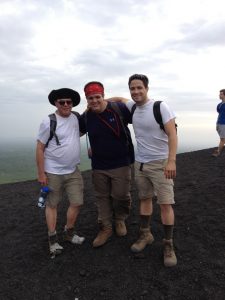 As I walk through the airport shortly after landing in Nicaragua, it still, in many aspects, feels like the first world that I’m already accustomed to. The human senses remain- surprisingly- very much unsurprised. In the recently constructed airport with nice aluminum finishes, the air conditioning still softly purrs, the smell of cleaner proliferates, and the sound of honking taxi cabs, constant chatter blended with some yelling, automatic doors opening and closing, and the rumble of cars and bus engines fill the air- in other words, nothing different from back home.
As I walk through the airport shortly after landing in Nicaragua, it still, in many aspects, feels like the first world that I’m already accustomed to. The human senses remain- surprisingly- very much unsurprised. In the recently constructed airport with nice aluminum finishes, the air conditioning still softly purrs, the smell of cleaner proliferates, and the sound of honking taxi cabs, constant chatter blended with some yelling, automatic doors opening and closing, and the rumble of cars and bus engines fill the air- in other words, nothing different from back home.
My comfortable state comes to a screeching halt when I step outside and feel the brutal combination of heat and humidity; insects barrage my arms and legs like gunfire. Of course, I seem to be the one most affected by this issue – others acclimate fine. Unfortunately, my bug spray does absolutely nothing.
We wait a short time, until the school buses arrive to take us to Grenada. The bus does everything and more to create an oppressive, even hotter, more humid environment. There is absolutely no cool air circulation; our foreheads are deluged in sweat within minutes. Even worse, I start feeling increasingly claustrophobic – a condition that I can earnestly say I have never felt before. The third world is striking with full force.
The bus heads into a new, unknown direction. I have absolutely no clue where we are going, but we eventually arrive in the city of Grenada, a bit south of the airport in Managua.
I browse the city with some of my fellow classmates and eventually stop for a bite to eat. After getting away from the airport, my senses are bombarded by reality. I see rusted gates, people desperate for money, buildings that would qualify as nothing more than shacks in the United States. I hear, as one would expect, plenty of Spanish. Even though I had believed that my Spanish comprehension skills had improved, the dialect and rapid pace of speech makes receiving answers an impossible task. Are they really speaking Spanish?
As I did in the airport, I feel much the same force of humidity and “stickiness.” As I stop to get something to eat, my tastebuds are met with an unpleasant surprise when I order a hamburger in a restaurant off the bustling street, which, by the way, has absolutely no methods for regulating intersections (no stop signs, no traffic lights). I thought it was impossible, but no- the burger I ordered was dry. Incredibly dry. The driest burger I have ever consumed. Some of my friends unanimously agree. Fortunately, though, I was able to find a gelato shop, essentially the Nicaraguan equivalent of Paciugo.
It’s time to head back to the airport in Managua to pick up the final school, Jesuit of New Orleans.
Another long and humid bus ride awaits as we head to Chinandega, located approximately three hours away. Chinandega, I learn, is the location of the Amigos For Christ compound, the organization that runs the trip.
The bus ride allows me to see even more of Nicaragua. A countless number of divisions create “houses” in singular buildings. Often times, many of the family members sit outside and relax or waive to passing vehicles.
Housing in Nicaragua doesn’t just differ than that of the United States simply because of the materials used or the size of the living quarters; housing in Nicaragua differs radically in that fellow Nicaraguans are granted access to other, nearby apartments. As I know, in the U.S. I don’t simply walk over to my neighbor’s house and walk right in without reason- but they can.This phenomenon reminds me of Jesuit. At Jesuit, there are commons, courtyards, tables, etc. and if someone wants to put themselves in that environment, he can do so freely (and often does).
After an excruciatingly long bus ride, we arrive at our final destination after 17 hours of travel that day (I woke up at 4:00 AM Central Time and finally sat down in the compound at 10:00 PM Central Time.) Saying that I am exhausted is an understatement. Unsurprisingly, I fall into a deep sleep. Goodnight, Nicaragua.
Day 2: Cerro Negro
Ah, it’s the first day of action in Nicaragua. I am not sure exactly what to expect for the trip in its entirety; however what I hear about Cerro Negro (the volcano that I am climbing today) is twofold. One, climbing Cerro Negro will require perseverance (a word that the Amigos For Christ staff said more than enough times). Two, Cerro Negro is approximately half a mile tall, approximately 3,050 feet long.
Before I arrive, I think to myself that the climb will surely not take a great toll.
I could not have been more mistaken.
We have a quick group stretch led by Jackson, an Amigos for Christ associate, before it’s time to hit the hills running. Left foot, left hand, right foot, right hand. My heart begins to pound in my chest like never before. In a similar fashion, my calves are rapidly fatiguing and aching. These physical conditions are taking their toll on my falling spirit. Is it worth it?
I finally decide to take a break. I look down to see just how far I have made it. I am so far from the bottom, yet so far from the top. In fact, I cannot even distinctly see the top.
Black ash fills in my shoes; I must keep pushing. Even with that in mind, I still fail to make it any further. Every step forward seemingly results in two steps back.
Seventy five percent progress is finally achieved, and I can see the top. But even more than before, my heart beats like a drum and, for the first time in my life, my legs begin to cramp.
So what, this is a once in a lifetime opportunity that I am not going to waste because I hurt a little! I know, more than anyone else, that I can reach the top.
Boom! I did it! I climbed more than I have ever climbed before on such a slippery and unforgiving surface.
To celebrate my achievement, I snap plenty of pictures of the surrounding environment. The views are no less than breathtaking. Mountains eclipse the horizon, and the black ash meets lush green vegetation in the most splendid way. I am on the same level (physical elevation) as some of the world’s greatest natural monuments. Best of all, however, is the fact that I have never experienced such a view before. In fact, I reckon that most people have never climbed a mountain and were able to immediately explore the world from an entirely new vantage point.
There is a common mantra that says “What goes up must come down.” Well, it’s time for me to make my way back down. But I am not going to simply walk down this thing – I am going to dash down Cerro Negro. Each step turns into a stride as I cannot even begin to slow myself down – I simply cannot hold back the momentum. That said, however, the experience is exhilarating
********************
After a nice, cold shower, I feel refreshed before I hit the hay in the living quarters. At the compound, there are two sets of housing for the Jesuit students and counselors. In my quarter, there are approximately 25 sets of bunk beds, each lined against the perimeter of the room, which, it turns out, makes for a very spacious living area. While air conditioning is absent, ten or so ceiling fans are present, making the environment bearable. Bathrooms are placed conveniently nearby and are blessed with running water, toilets and showers, albeit the showers are rather cold. It has been a long day, and I jump onto the top bunk (Rob Giltner ’13, on the bottom bunk) for a deep sleep.


